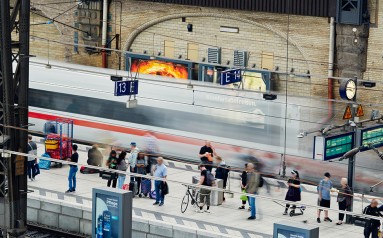Page content
Right on track

Another milestone has been reached on the road to the digitalisation of European rail transport with the new TSI CCS coming into force in September 2023. Harmonisation of the predominantly non-interoperable European train control and command systems with compatible systems, technologies and procedures is intended in order to improve capacity, safety and timeliness of rail transport in the European Union (EU) and the trans-European transport network. Trains should be able to travel from Paris to Bratislava or from Berlin to Palermo without having to change systems or even replace train drivers at national borders.
In line with climate targets, the European Commission stipulated in its 2011 White Paper that a major part of passenger transport over medium distances should be carried out by rail by 2050 at the latest. In the medium term, by 2030, it is aiming to triple the length of the existing high-speed rail network and create a dense rail network in all member states. Ultimately, the EU's high-speed rail network shall be fully developed. The EU Commission also wants to expand rail freight transport.
The digitalisation of rail transport plays a decisive role. The TSI CCS is an important guideline for achieving these goals. However, the specifications have not yet been defined for all subsystems and further research and development work is required. Among other things the radio communication and data communication subsystems specifications still have to be established.
ETCS rollout
In order to implement ETCS, extensive structural measures are required along the railway infrastructure. Tracks must be equipped with modern signaling technology to ensure the precise transmission of data and the interlocking boxes must be converted to ETCS, for example.
On the other hand, the rolling stock also needs ETCS-compatible equipment. For instance, sensors and communication equipment must be installed in trains to enable interaction with the new system.
So far, implementation has progressed differently country by country. Switzerland is regarded as being the pioneer, having migrated almost its entire rail network to ETCS. The Netherlands have also equipped most of their network, including both the Amsterdam-Utrecht and Rotterdam-Arnheim high-speed lines. In Germany, on the other hand, only around 500 kilometres of the rail network are ETCS-capable, including the high-speed Cologne-Rhine/ Main connection. Construction is currently underway on the Leipzig-Dresden line. By 2030, all high-speed lines are expected to be ETCS-capable. Sweden wants to convert its network by 2035.
Decision on FRMCS
ETCS transmits information to train drivers directly through the Driver Machine Interface (DMI) in the driver's cab. This involves the exchange of data between Eurobalises in the track bed, balise antennas on the traction unit, turnouts and interlockings. This also has an impact on train radio communications. The digitalisation of the railway system generates far higher data volumes than the current GSM-R train radio can handle. GSM-R is based on the second generation of mobile radio (2G). However, GSM-R is no longer sufficient for the necessary real-time data transmission between train and the railway line.
The TSI CCS, which has now come into force, stipulates for the first time that FRMCS will replace GSM-R in the long term. During the transition period, the TSI introduces the Railway Mobile Radio (RMR). It comprises both GSM-R and FRMCS with the latter being based on 5G. (Read more about FRMCS on page 4.)
Field tests are expected to provide further specifications for FRMCS. To carry them out, the International Union of Railways (UIC) has launched the MORANE 2 project. Results are to be obtained by 2026. After that, there will be a follow-up TSI which will further specify FRMCS for the first time. The commitment to FRMCS last September makes it possible for the rail industry to combine the necessary conversions and installations on rolling stock and lines and thus reduce costs as well as line closures incurred during construction work.

